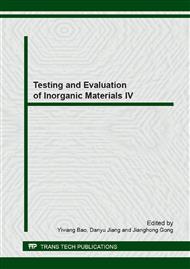[1]
A. Kayani, T. L. Buchanan, M. Kopczyk, et al. Oxidation resistance of magnetron-sputtered CrAlN coatings on 430 steel at 800°C, surface and coating technology. 201(2006)4460-4466.
DOI: 10.1016/j.surfcoat.2006.08.049
Google Scholar
[2]
Y. Makino, K. Nogi. Synthesis of pseudobinary Cr-AI-N films with Bl structure by r. f. -assisted magnetron sputtering method, surface and coating technology. 98(1998)1008-1012.
DOI: 10.1016/s0257-8972(97)00391-5
Google Scholar
[3]
A. Kimura, M. Kawate, H. Hasegawa, et al. Anisotropic lattice expansion and shrinkage of hexagonal TiAlN and CrAlN films, surface and coating technology. 167-170(2003)367-370.
DOI: 10.1016/s0257-8972(03)00040-9
Google Scholar
[4]
A. E. Reiter, V. H. Derflinger, B. Hanselmann, et al. Investigation of the properties of Cr1-xAlxN coatings prepared by cathodic arc evaporation, surface and coating technology. 200 (2005) 2114-2122.
DOI: 10.1016/j.surfcoat.2005.01.043
Google Scholar
[5]
Y. Setsuhara, T. Suzuki, Y. Makino, et al. Phase variation and properties of ( Ti, Al )N films prepared by ion beam assisted deposition, surface and coating technology. 97(1997)254-258.
DOI: 10.1016/s0257-8972(97)00160-6
Google Scholar
[6]
A. Sugishima, H. Kajioka, Y. Makino. Phase transition of pseudobinary Cr-Al-N films deposited by magnetron sputtering method, surface and coating technology. 97(1997)590-594.
DOI: 10.1016/s0257-8972(97)00402-7
Google Scholar
[7]
K. P. Zheng, P. Liu, W. Li, et al. Impacts of Al content on microstructures and mechanical properties of CrAlN coatings, Chinese Journal of Vacuum Science and Tevhnology. 31(2011)686-690.
Google Scholar
[8]
J. L. Endrino, G. S. Fox-Rabinovich, A. Reiter, et al. Oxidation tuning in AlCrN coatings, Surface and Coatings Technology. 201(2007)4505-4511.
DOI: 10.1016/j.surfcoat.2006.09.089
Google Scholar
[9]
T. Ikeda, H. Satoh. Phase formation and characterization of hard coatings in the Ti-Al-N system prepared by the cathodic arc ion plating method, Thin Solid Films. 195(1991)99-110.
DOI: 10.1016/0040-6090(91)90262-v
Google Scholar
[10]
R. Franz, J. Neidhardt, B. Sartory. High-temperature low-friction properties of vanadium-alloyed AlCrN coatings, Tribology Letters. 23(2006)101-107.
DOI: 10.1007/s11249-006-9064-1
Google Scholar
[11]
Y. Sun, T. Bell, S. Zheng. Finite element analysis of the critical ratio of coating thickness to indentation depth for coating property measurements by nanoindentation, Thin solid films. 258 (1995) 198-204.
DOI: 10.1016/0040-6090(94)06357-5
Google Scholar


